Teodorescu P.P. Mechanical Systems, Classical Models Volume I: Particle Mechanics
Подождите немного. Документ загружается.

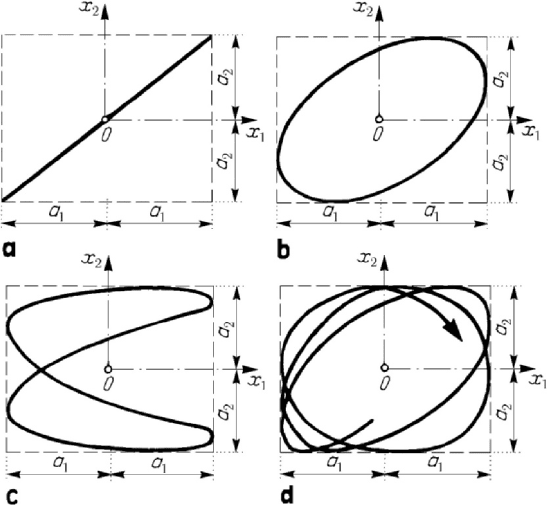
MECHANICAL SYSTEMS, CLASSICAL MODELS
502
2/T πω= , multiple of the periods of all the other oscillations, hence the period of the
motion
()xt ), being called fundamental (or harmonic) oscillation. The oscillation
expressed by the term
cos( )
nn
antωϕ
−
has the frequency
min
n
nνν
=
and is called
harmonic of nth order. The set of amplitudes and the set of phases of the harmonic
oscillations which compose a periodic motion form the amplitudes spectrum and the
phases spectrum, respectively.
2.2.5 Composition of orthogonal harmonic vibrations. Small oscillations around a
stable position of equilibrium
Let be the harmonic vibrations
11 1 1
cos( )xa tωϕ=−,
22 2 2
cos( )xa tωϕ
=
−
along two orthogonal directions (corresponding to the
1
Ox -axis and to the
2
Ox -axis,
respectively); by their composition, one obtains a motion the trajectory of which is
contained in the rectangle
111
axa−≤ ≤,
222
axa
−
≤≤.
Figure 8.25. Composition of orthogonal harmonic vibrations:
12
ωω
=
,
12
ϕϕ= (a);
12
ωω= ,
12
ϕϕ≠ (b); Lissajous’ curves (c);
12
/ nωω
≠
, n
∈
(d).
If
12
ωω= and
12
ϕϕ= , then, eliminating the time t , it results
2211
/xaxa= ,
hence the trajectory of the linear oscillator thus obtained is the diagonal of the

Dynamics of the particle in a field of elastic forces
503
mentioned rectangle (Fig.8.25,a). If
12
ωω
=
and
12
ϕϕ
≠
, then it results an elliptic
oscillator (Fig.8.25,b) of equation
22 22 22 2
21 12 1 2 12 12 12 1 2
2cos( ) sin( )ax aa xx ax aaϕϕ ϕϕ−−+=−
,
obtained by elimination of the time
t
.
If
12
ωω
≠
and
12
/ nωω
=
, n
∈
(the pulsations
1
ω and
2
ω are
commensurable), then it exists a period
T
, the smallest common multiple of the
periods of the two component motions, so that the motion is periodic, while the
trajectory of the particle
P
is a closed curve, called Lissajous curve; the trajectory
corresponding to the case
12
2ωω
=
,
1
/4ϕπ
=
,
2
0ϕ
=
is given in Fig.8.25,c. If the
pulsations are not commensurable, then the motion can no more be periodic and the
trajectory is an open curve which covers the whole rectangle mentioned above
(Fig.8.25,d).
Analogously, one may compose three orthogonal harmonic vibrations
cos( )
ii i i
xa tωϕ=−, 1, 2, 3i
=
,
(8.2.32)
corresponding to the axes
1
Ox ,
2
Ox and
3
Ox , respectively; one obtains thus a
trajectory contained in the parallelepipedon
iii
axa
−
≤≤, 1, 2, 3i
=
. However, one
may thus study the small oscillations of a particle around the pole
O , considered as a
stable position of equilibrium. We assume that the force which acts upon the particle is
conservative (
gradU=F ), the potential U being developable into series
(
0
12
...UU U U=+++
,
i
U
, 0,1,2,...,i
=
homogeneous polynomial of ith degree in
the co-ordinates
123
,,xxx). Because the components of the force
F
are obtained as
derivatives of the potential
U
, we may take
0
0U
=
; as well, we must have
1
0U =
,
because the origin is a position of equilibrium. Assuming that we have to do with small
motions, we take
2
UU=
, neglecting the polynomials of higher order; we notice also
that one must have
2
0U <
, the pole
O
being a stable position of equilibrium (the
trajectory must be entirely at a finite distance). One may take
()
22 22 22
123 112233
(, , )
2
m
Ux x x x x x
ωωω=− + +
(8.2.32')
in this case; we are thus led to the equations of motion
2
111
0xxω+= ,
2
222
0xxω
+
= ,
2
333
0xxω
+
= ,
(8.2.32'')
the solutions of which are the harmonic vibrations (8.2.32). The trajectory of the
particle
P is a closed curve (a Lissajous curve), the motion being periodic if and only
if the pulsations (hence the periods and the frequencies too) are commensurable (are
proportional to integer numbers
11 22 33
///nnnωωω
=
= ,
123
,,nnn∈ ).
Otherwise, the trajectory is an open curve which covers entirely the above mentioned
parallelepipedon; the particle does not pass twice through the same position, but may
pass as close as possible to it in a sufficiently long time.
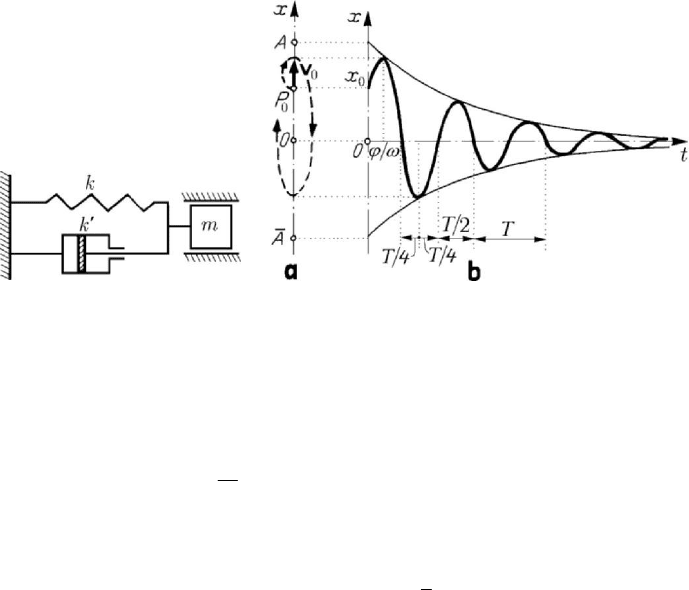
MECHANICAL SYSTEMS, CLASSICAL MODELS
504
2.2.6 Damped linear oscillator
If, besides a linear elastic spring (Fig.8.8), we introduce, in parallel, a viscous
damper with a damping coefficient
0k
′
> , then we obtain the physical model of a
damped linear oscillator (Fig.8.26). Using the notations in Subsec. 2.1.3, it results the
equation of motion (along the
Ox -axis)
Figure 8.26. Model of a viscous Figure 8.27. Damped linear oscillator: trajectory (a);
damped linear oscillator. diagram
()xt
vs t (b).
2
20xxxλω
+
+= ;
(8.2.33)
with the initial conditions (8.2.23'), we obtain the solution
000
1
( ) e cos ( )sin e cos( )
tt
xt x t v x t a t
λλ
ωλω ωϕ
ω
−−
⎡⎤
′′′
=++=−
⎢⎥
′
⎣⎦
,
(8.2.33')
corresponding to a subcritical damping (
1χ
<
). The motion is a pseudoperiodic
damped motion, of pseudoperiod
2/T πω
′
=
, the trajectory of which starts from the
point
0
P , being contained in the segment of a line
AA
and tending to the asymptotic
point
O after an infinity of oscillations around this pole (Fig.8.27,a). This motion
constitutes a vibration modulated in amplitude, being strongly damped; the diagram of
the motion has the aspect of a cosinusoid contained between the curves
e
t
xa
λ−
=±
and tangent to these ones at the points
/t ϕω
′
=
, /tTϕω
′
=
+ ,… and /t ϕω
′
=
/2T+ , /t ϕω
′
=
3/2T+ ,…, respectively (Fig.8.27,b).
In case of a critical damping (
1χ
=
), we obtain an aperiodic damped motion given
by
[
]
00 0
() e ( )
t
xt x v x t
λ
λ
−
=++.
(8.2.33'')
If
0
0v >
, then the particle starts from the point
0
P
, reaches A at the moment
000
/( )tv v xλλ
′
=+, and then changes of direction tending asymptotically to the
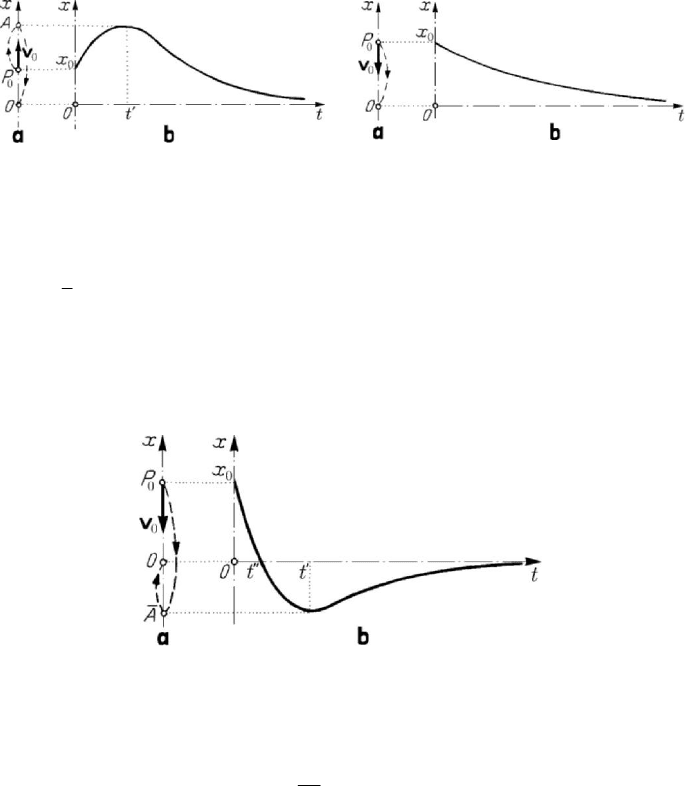
Dynamics of the particle in a field of elastic forces
505
centre
O (Fig.8.28,a); the diagram of motion has a point of maximum for tt
′
= ,
tending asymptotically to zero (Fig.8.28,b). If
00
0xvλ
−
≤≤, then the particle starts
from
0
P , tending asymptotically to zero (Fig.8.29,a). The corresponding diagram has
neither zeros, nor points of extremum (Fig.8.29,b); in the case in which
00
/2 0xvλ−<< appears a point of inflection. If
00
vxλ
<
− , then the particle starts
Figure 8.28. Linear critical damping; case Figure 8.29. Linear critical damping; case
0
0v >
: trajectory (a); diagram
00
0xvλ
−
≤≤ (a); diagram
()xt vs
t
(b). ()xt vs
t
(b).
from
0
P , passes through the centre O at the moment
00 0
/( )txvxλ
′
′
=
−+ and
reaches
A at the moment t
′
and returns asymptotically towards the centre O
(Fig.8.30,a); the diagram of motion pierces the
Ot -axis at the point tt
′′
= , has a
minimum for
tt
′
= , tending then asymptotically to zero with negative values
(Fig.8.30,b). If the point
0
P is at the left of the pole O , hence if
0
0x < , then one
obtains, by symmetry, analogous results.
Figure 8.30. Linear critical damping; case
00
vxλ
<
− (a); diagram ()xt vs t (b).
A supercritical damping (
1χ > ) leads to an aperiodic damped motion of the form
000
1
() e cosh ( )sinh
t
xt x t v x t
λ
ωλω
ω
−
⎡⎤
′
′′′
=++
⎢⎥
′′
⎣⎦
.
(8.2.33''')
In what concerns the trajectory and the diagram of motion, one obtains the same
qualitative results as above as
0
0v > ,
00
() 0xvλω
′
′
−
+≤≤ or
00
()vxλω
′′
<− +
(Figs.8.28-8.30); we observe that

MECHANICAL SYSTEMS, CLASSICAL MODELS
506
0
2
00
1
arg tanh
v
t
xv
ω
ω
ωλ
′
′
′
=
′′
+
,
0
00
1
arg tanh
x
t
vx
ω
ωλ
′
′
−
′′
=
′′
+
.
Multiplying the equation (8.2.33) by
mx , we obtain
2
dd
()()
dd
TV TU kv
tt
′
+= −=−
,
(8.2.34)
so that the sum between the kinetic energy and the potential energy decreases (is
dissipated) in time. In case of a subcritical damping, we observe that (abstraction of an
additive constant)
[]
2
222
() () () e cos2( ) sin2( )
2
t
ma
Et Tt Ut t t
λ
ωλ ω ϕλω ωϕ
−
′′′
=−= + −+ −
,
so that
2
()e ()
T
Et T Et
λ
−
+= ,
(8.2.34')
where
Tδλ=− is the logarithmic decrement of motion; hence, the mechanical energy
of the pseudoperiodic damped linear oscillator decreases in geometric progression.
The relative energy dissipated in an interval of time equal to a pseudoperiod is given by
2
() ( )
1e
()
Et Et T
Et
δ
−+
==−
,
(8.2.34'')
being constant in time.
Figure 8.31. Model of a Coulombian damped linear oscillator.
The case considered above corresponds to a viscous damping force (the magnitude of
which is proportional to the velocity). In the case of a Coulombian dry damped force
(of constant magnitude during the motion), modelled physically as in Fig.8.31, the
equation of motion is of the form
2
sign 0xx x
m
Φ
ω
+
+=
(8.2.35)
and leads to
0
0
() ( )cos sin
aa
v
xt x t t
δω ωδ
ω
=± + ∓ ;
(8.2.35')

Dynamics of the particle in a field of elastic forces
507
we take
sign 1x =±
, denote by /
a
kδΦ
=
the displacement along the spring of elastic
constant
k due to the force of dry friction
Φ
and put the initial conditions (8.2.23').
We must study the motion piecewise after the direction of the velocity
x (in fact, on
semi-pseudoperiods). Without any loss of generality, we may assume that the particle
P starts from the point
0
P of abscissa
0
0x > without initial velocity (
0
0v = ); in
these conditions, the motion can take place if and only if the damping force is less than
the elastic force at the initial moment, hence if
0
kxφ
<
or
0
a
xδ
<
. The particle
begins to move with a negative velocity, so that its position is specified by
0
() ( )cos
aa
xt x tδωδ=− +, 0/2tT
≤
≤ , till it reaches the point
1
P of abscissa
0
1
(2)
a
xxδ=− − , after a semi-pseudoperiod /2 /T πω
=
(when the velocity
0
() ( )sin
a
vt x tωδω=− − vanishes). If
1
0x > , then
0
2
aa
x δδ
−
+<, the particle
remaining further in permanent rest; hence, if the stop point is at the same part as the
point of start (in particular, the initial position) with respect to the centre
O , then the
stopping is final. But if the point of stopping is situated on the other part of the centre
O , then the particle moves further as the condition
0
2
aa
x δδ
−
> , hence the condition
0
3
a
x δ> is verified or not (Fig.8.32). If this condition is fulfilled, then the particle
continues to move with a positive velocity, in an interval of time equal to a new semi-
pseudoperiod, hence after the law
0
() ( 3 )cos
aa
xt x tδωδ
=
−−, /2TtT≤≤ ,
which verifies the new conditions at the point
1
P , at the moment /2tT= , till the
point
2
P of abscissa
0
2
4
a
xx δ=−. An analogous reasoning is then made. Supposing
Figure 8.32. Coulombian damped linear oscillator. Trajectory.
that the conditions of motion are fulfilled, the particle reaches the point
n
P of abscissa
0
(1)( 2 )
n
na
xxnδ=− − after n semi-periods; the abscissae of this oscillatory motion
decrease in an arithmetic progression of ratio
2
a
δ
−
. The motion ceases always after a
finite number of semi-pseudoperiods, let be
n semi-pseudoperiods. The particle passes
over the point
1n
P
−
and stops at the point
n
P if
0
(2 1) (2 1)
aa
nxnδδ
−
<< + . If
0
(2 1) 2
aa
nxnδδ−<<, hence if
0
/2 1/2 1/2
a
nx nδ
<
+<+, then the point
n
P
is at the same part of the centre
O
as the point
1n
P
−
, if
0
2
a
nxδ
<
(2 1)
a
n δ<+,
hence if
0
/2 1/2
a
nx nδ<<+, then the point
n
P is at the other part of the centre
O
as the point
1n
P
−
, while if
0
2
a
xnδ
=
, hence if
0
/2
a
nx δ
=
, then the point
n
P at
which the particle ceases to move coincides with the centre
O
. We denote
[
]
0
1
E/2
a
nxδ= and
[
]
0
2
E/2 1/2
a
nxδ
=
+ , where
[
]
E q represents the greatest
natural number contained in the number
q
; if
12
nnn
=
= , then the particle stops at
n
P ,
after
n semi-pseudoperiods, the centre
O
being contained in the interior of the segment of
a line
1
n
n
PP
−
, if
21
1nn=+
, then
2
nn
=
, and the particle stops after n semi-
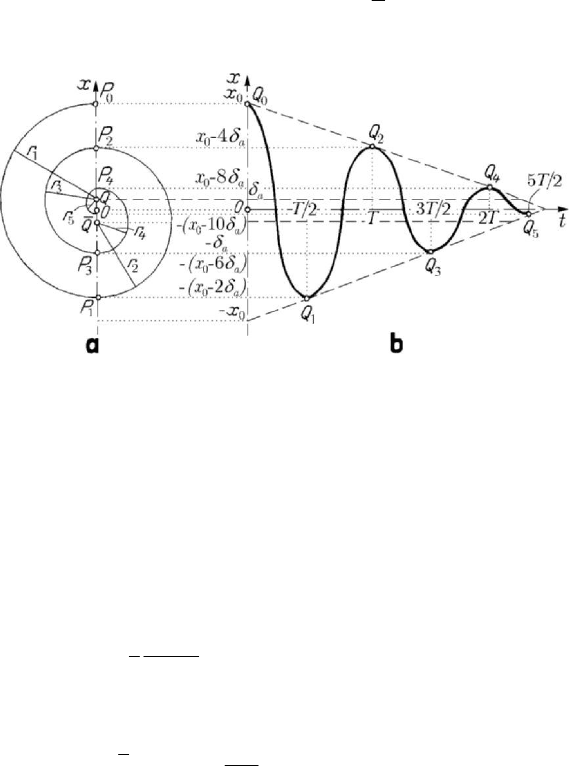
MECHANICAL SYSTEMS, CLASSICAL MODELS
508
which decrease in arithmetic progression and of axes which differ by
a
δ∓
with respect
to the
Ot -axis, the motion ceasing when the amplitude is less than
a
δ (in Fig.8.33,b is
taken
5n = ); the points
0
24
,,QQQ and
5
13
,,QQQ of matching the arcs of cosinusoid
are collinear, respectively, but the straight lines
0
(4/)
a
xx tTδ
=
±− are not tangent
to those arcs at the respective points. We notice that the motion during each semi-
pseudoperiod may be obtained as a projection of a uniform circular motion on a
semicircle with the centre at
Q of abscissa
a
δ or at Q , of abscissa
a
δ− , and of radii
5
13
,,rrr or
24
,rr, respectively (Fig.8.33,a).
Figure 8.33. Coulombian damped linear oscillator. Trajectory as projection of circular
uniform motions on semicircles (a); diagram
()xt
vs t (b).
The damping by dry friction forces is, in fact, a particular case of non-linear
damping. Another important such case is that of a hydraulic damping force, in direct
proportion to the square of the velocity, which leads to an equation of the form
22
2sign 0xx xxλω++= ;
(8.2.36)
proceeding as in Chap. 7, Subsec. 1.3.3, we may write the equivalent equation
(
)
2
22
d
1
2sign 0
2d
x
xxx
x
λω
+
+=
,
wherefrom we obtain the equation with separate variables
2
24sign
2
e(14sign)
8
x
xC x x
λ
ω
λ
λ
−
=+−
,
(8.2.36')
pseudoperiods at the point
n
P , on the same part as the point
1n
P
−
with respect to the
centre
O , while if
0
1
/2
a
nx nδ==, then the particle stops at the centre O , after an
interval of time equal to the respective number of semi-pseudoperiods. The diagram of
motion may be represented by a succession of arcs of cosinusoid, with amplitudes
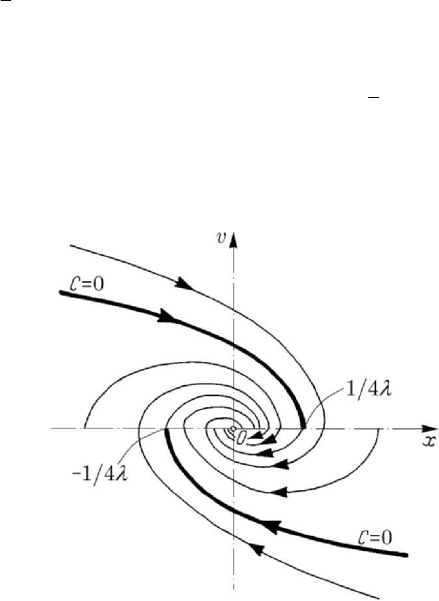
Dynamics of the particle in a field of elastic forces
509
the constant
C being determined by the condition of vanishing the velocity at the
points where that one changes of direction. We notice that, replacing
x by x− and x
by
x− , one obtains the same result; hence, the representation of the motion in the
phase space is symmetric with respect to the pole
O , the representation in the upper
semiplane being thus sufficient. Denoting
22
/8a ωλ= , CaC
=
, we may write for
the upper semiplane
(
)
[
]
2444
14 e e (4 1)e
xx x
va xC a C x
λλ λ
λλ
−
−
=−+ = − − .
(8.2.36'')
Figure 8.34. Hydraulic damped linear motion. Phase trajectory.
The points at which the phase trajectory pierces the
Ox -axis are given by the
equation
4
(4 1)e
x
xC
λ
λ −= (for 1C
<
− there is not one point, for 1C =− there
exists the crunode
0x = , for 10C
−
<< there exist the points
1
0x
<
and
2
0x > ,
for
0C → there correspond
1
x →∞ and
2
1/4x λ→ , while for 0C ≥ there exists
only one point
2
1/4x λ≥ ). It results that for 10C
−
<< one obtains closed phase
trajectories, those ones having branches at infinity for
0C > . The separation curve is
the parabola
2
(1 4 )va xλ=− , corresponding to
0C
=
(Fig.8.34).
2.2.7 Repulsive elastic forces. Self-sustained motions
In case of a repulsive elastic force of the form
()Fx kx
=
, 0k > , the equation of
motion is given by (we use the notations in Subsec. 2.1.2)
2
0xxω
−
= ;
(8.2.37)
with the initial conditions (8.2.23'), we obtain

MECHANICAL SYSTEMS, CLASSICAL MODELS
510
0
0
cosh sinh
v
xx t t
ωω
ω
=+,
00
cosh sinhvv t x tωω ω
=
+ .
(8.2.37')
To fix the ideas, we assume that
0
0x > . If
0
0v > , then the particle travels through a
half straight line, starting from
0
P , in the positive direction of the Ox -axis
(Fig.8.35,a); the respective diagram of motion is given in Fig.8.35,b, the curve being
asymptotic to a hyperbolic cosine. If
00
0xvω
−
<<, then the particle starts from
0
P ,
reaches
A and
Figure 8.35. Particle acted upon by a repulsive elastic force; case
0
0v ≥ :
linear trajectory (a); diagram
()xt vs t (b).
then changes the direction of motion and tends to infinity in the positive sense of the
Ox -axis (Fig.8.36,a); the diagram of motion has a minimum
22
00
min
(/)xxvω=−
for
00
arg tanh( / )tvxω
′
=−, tending asymptotically to a hyperbolic cosine
(Fig.8.36,b). If
00
vxω<− , then the particle starts from
0
P , reaches O at the moment
Figure 8.36. Particle acted upon by a repulsive Figure 8.37. Particle acted upon by a
elastic force; case
00
0xvω−<<: repulsive elastic force; case
00
vxω<− :
trajectory (a); diagram
()xt vs t (b). trajectory (a); diagram ()xt vs t (b).
00
arg tanh( / )txvω
′′
=−, tending then to infinity in the negative sense of the
Ox -axis (Fig.8.37,a); the diagram of motion has a point of inflection at t
′′
on the
Ot -axis and tends asymptotically to a hyperbolic cosine (Fig.8.37,b). All these
motions are aperiodic and non-damped. If
00
vxω
=
− , then we obtain
00
(cosh sinh ) e
t
xx t t x
ω
ωω
−
=−=, so that the particle starts from
0
P
and tends
asymptotically towards the centre
O
, the motion being damped (it is an interesting case

Dynamics of the particle in a field of elastic forces
511
of damping due to the initial conditions) and aperiodic (Fig.8.29,a); the diagram of
motion is of the same form as that in Fig.8.29,b.
If a viscous damping force intervenes too, then the equation of motion takes the form
2
20xxxλω
+
−=
,
(8.2.38)
with the notations in Subsec. 2.1.3; with the same initial conditions, it results
000
1
() e cosh ( )sinh
t
xt x t v x t
λ
ωλω
ω
−
⎡⎤
=++
⎢⎥
⎣⎦
,
22
ωλω=+,
(8.2.38')
2
000
1
() e cosh ( )sinh
t
vt v t x v t
λ
ωωλ ω
ω
−
⎡⎤
=+−
⎢⎥
⎣⎦
.
(8.2.38'')
One obtains the same qualitative results for the trajectory and for the diagram of
motion, as
0
0v ≥ , as
00
() 0xvλω
−
+<<, as
00
()vxλω
<
−+ or as
0
v
0
()xλω=− + , respectively (Figs 8.35-8.37, 8.29); we observe that
0
2
00
1
arg tanh
v
t
vx
ω
ω
λω
′
=
−
,
0
00
1
arg tanh
x
t
vx
ω
ωλ
−
′′
=
+
.
In what concerns the diagram in Fig.8.37,b, the point of inflection is no more on the
Ot -axis, but corresponds to
(
)
()
2
00
22 2
00
2
1
arg tanh
vx
tt
vx
ωλ ω
ω
λω λω
−
′′′ ′′
=>
+−
.
In case of self-sustained motions of the particle, we use the considerations in Subsec.
2.1.4. For an elastic force of attraction, the equation of motion is of the form
2
20xxxλω
−
+= .
(8.2.39)
We obtain
000
1
( ) e cos ( )sin e cos( )
tt
xt x t v x t a t
λλ
ωλω ωϕ
ω
⎡⎤
′′′
=+−=−
⎢⎥
′
⎣⎦
,
(8.2.39')
hence a subcritical damping (we assume that
ωλ> , hence
1χ
<
) for which the
pseudopulsation
ω
′
is given by (8.2.15''), the pseudoperiod being 2/T πω
′
= . The
trajectory, which starts from the point
0
P
, has amplitudes more and more greater
(Fig.8.38,a), being thus modulated in amplitude; the diagram of motion has the aspect
of a cosinusoid contained between the curves
e
t
xa
λ
=
±
and tangent to them
(Fig.8.38,b). If
ωλ= (critical damping, 1χ
=
), we may write
[
]
00 0
() e ( )
t
xt x v x t
λ
λ=+−
.
(8.2.39'')
